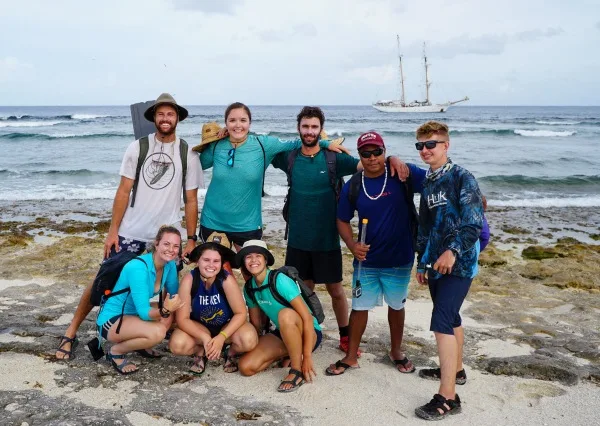Programs Blog
Adventure on Orona

Brandon Hopper, UC Santa Barbara
Ship’s Log
Current Position
4° 30.87’ S, 172° 16.65’ W
Ship’s Heading and Speed
N/A
Sail Plan
Anchored at Orona for the next day or two
Weather
Steady winds, scattered clouds
We arrived at Orona yesterday afternoon after an unforgettable time on Kanton. Today started around 6am with a beautiful sunrise and tasty chocolate chip pumpkin pancakes. After some quick chores, our watch group packed up the small boat and made our way over to the beach. Due to large swells and a sharp rocky beach, getting everyone from the boat to the beach was a little tricky. Luckily, there is a natural cut in the reef where the waves calm and the beach is a bit more accessible. After a little bit of swimming and slipping, we made it ashore safely.
 Clams in the Lagoon
Clams in the Lagoon
Orona, like all of the islands within PIPA, is an atoll made up of a lagoon surrounded by a ring of land. Coconut palms are abundant across most of the uninhabited island. We made our way up the beach past thousands of seabirds and until we found the large, shallow cut that connects the ocean to the lagoon inside Orona (it’s not quite deep enough to get the small boat through). The cut was filled with baby black tip reef sharks. We set up base at the lagoons edge and threw on our snorkeling gear. The underwater life within the lagoon was pretty spectacular. Large, colorful clams covered almost every square inch of the underwater structure and masses of reef fish (parrotfish, triggerfish, angelfish, butterfly fish, etc.) lived among them. There were also some larger fish like snappers, trevally, and one of my favorites, the humphead wrasse.
After hanging out at the lagoon for a while, we made our way back to the ship for a pasta and pizza lunch, followed by some fresh bread for snack (the food on this trip has been pretty incredible). We relaxed through the afternoon and evening with the occasional anchor watch that we were tasked with. The ocean floor drops off very rapidly just off the coast of Orona so we are forced to anchor pretty close to the reef. Every half hour somebody needs to check all of the electronics (depth, radar, etc.), check the anchor line direction/tension, take visual bearings of the island, and observe the weather to insure that the wind or current isn’t shifting and putting us on the reef. It’s a good feeling to be an active part of the crew, rather than just a passenger. Cap and the mates are filled with nautical knowledge and it has been a great experience getting to absorb some of it.
After a wonderful dinner, as the sun started to set, a squall rolled through and started dumping rain so Miita, Silas, and I went up to the bow for a rain shower. This was the first time on this trip that I’ve been cold and it was glorious. This evening has been filled with project work and blog writing in my case.
After today’s adventure, it really became clear how remote we are and how few people have been to this place. I can’t imagine a better place to be a student.
Cheers to new friends and new experiences,
– Brandon (UC Santa Barbara)
(Shoutout to Mom, Shane, Mimi, Larry and the rest of the fam I love you guys!)
Recent Posts from the Ships
- Ocean Classroom 2024-A collaborative high school program with Proctor Academy
- Collaborations and Long-term Commitments: SEA’s Caribbean Reef Program Sets a Course for Coastal Programs that Compliment Shipboard Experiences.
- Sea Education Association students prepare for life underway using state of the art nautical simulation from Wartsila Corporation.
- SEA Writer 2022, Magazines From the Summer SEA Quest Students
- Technology@SEA: Upgrades Allow Insight into Ocean Depths
Programs
- Gap Year
- Ocean Exploration
- High School
- Science at SEA
- SEA Expedition
- SEAScape
- Pre-College
- Proctor Ocean Classroom
- Protecting the Phoenix Islands
- SPICE
- Stanford@SEA
- Undergraduate
- Climate and Society
- Climate Change and Coastal Resilience
- Coral Reef Conservation
- Marine Biodiversity and Conservation
- MBL
- Ocean Exploration: Plastics
- Ocean Policy: Marine Protected Areas
- Oceans and Climate
- Pacific Reef Expedition
- The Global Ocean: Hawai'i
- The Global Ocean: New Zealand